On August 11, 2010, we visited Corfe Castle in the Isle of Purbeck, East Dorset. We didn’t realise until the morning that it happened to be the birthday of children’s book writer Enid Blyton, who featured Corfe as Kirrin Castle in her Famous Five books. So it was a busier day than usual at the tourist attraction.

It was Enid Blyton's birthday and as part of the celebrations at Corfe a couple were reading from the old and new (politically correct) versions of The Famous Five...
The castle also features in the science fiction alternative history novel Pavane by Keith Roberts – one of my favourites.
The Isle of Purbeck is famous for its building stone – marble was quarried here as far back as Romano Celtic times, although they took a break during the Dark Ages, between the leaving of the Romans and the arrival of the Normans.
The Normans soon built a wooden fort at Corfe and by 1106 they had replaced this with a stone keep atop the hill.
This was developed over the centuries until Corfe Castle became the largest and most beautiful medieval castle in Dorset, with a village growing at its feet.
The village’s Church of St Edward, King and Martyr, was built in the 13th century, the tower added around 1400 and everything but the tower remodelled in the 19th century.
But the big story of Corfe is its role in the English Civil War. In 1643 most of Dorset was in the hands of Oliver Cromwell’s Parliamentarians but Corfe Castle was owned by Royalist Sir John Bankes.
The castle was first besieged in 1643 while Sir John was away with the King (Charles I) so his wife Lady Mary Bankes held the fort – literally – and survived despite having to give up her four cannon when the Parliamentarians threatened to burn the villagers’ homes.
Sir John died in 1644 and Lady Mary faced another siege in 1646. This time the castle fell but only through treachery – one of her own officers, a Colonel Pitman, let in the enemy through a sally port (side gate).
Despite losing the castle, for her bravery Lady Mary was allowed to keep the keys – not that they were much used to her as the castle was utterly destroyed by the Parliamentarians, using gunpowder. They did a good job and much of the stone was reused to make the cottages we see in the village today.
It’s now a romantic ruin with views over a gap towards the sea at Poole and is now run by the National Trust.

The magnificent Keep of Corfe Castle was built by 1105 by Henry I. It was a 21-metre (70-ft) tower on a 55-metre (180-ft) hill, so the shining cream-coloured edifice must have been a sight to see...

The name Corfe means 'gap' and here's why - from the castle you can see through a gap in the hills towards Poole Harbour. The castle can also of course be seen from certain parts of the harbour
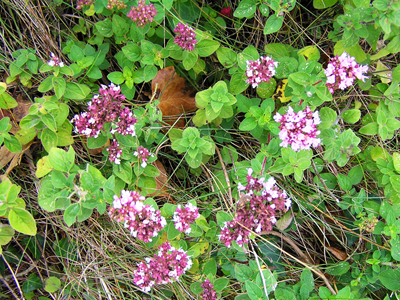
The limestone rocks of the ruined castle are a habitat for wild flowers - this looks like marjoram but I didn't think to crush the leaves at the time to smell them

And another beautiful flower among the ruins - I think this is a relative of the speedwell (Veronica)...

The Gloriette - built by King John (reigned 1199-1216) as a beautiful royal residence - 'gloriette' means a 'highly decorated chamber'

Part of the lovely stained glass in Corfe Castle church - it reads 'He maketh the storm to cease so that the waves thereof are still'
Can’t get enough of Corfe? There’s also a model village in the village – it was opened in 1966 and is built to a 1/20th scale. Go to the official website here.
I used to visit the model village as a child, with my Grampy Giles, and it still has a certain charm, oriented in the same direction as the real village itself, so from one end you can see the model castle alongside the real ruined castle and at the other the model church alongside the real church.
It even has its own model village within the model village…

Although the model village mostly reflects life before the Civil War, it does have a replica of the model village tea room...

Model church in the model village at Corfe - listen carefully and you can hear church music coming from inside...
Click here to find out more about the Swanage Railway.


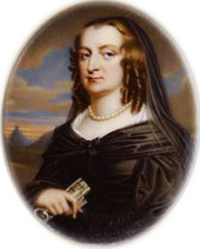



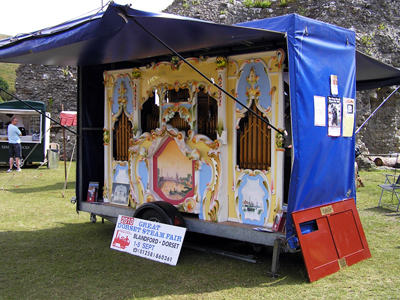




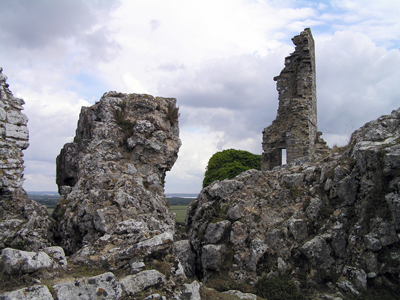





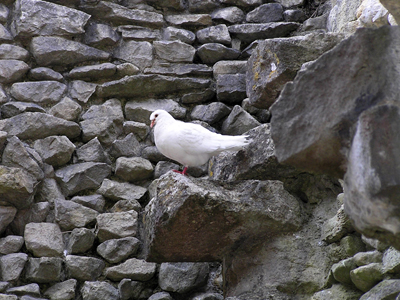













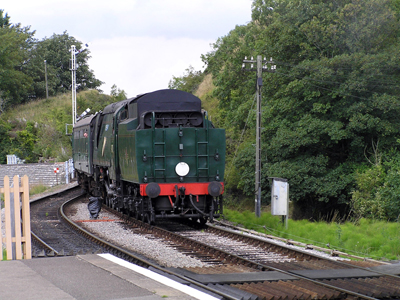




Leave a comment